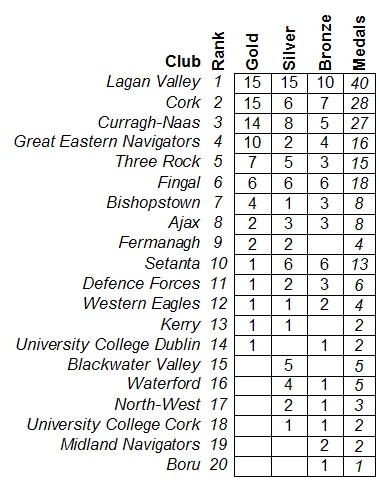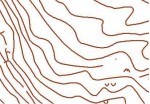May 29, 2009
Ajax Juniors feature in National Champs

Ruari and Roisin both took 2nd place on Day 2 , Ruari in M10 and Roisin in W14.
Here's Ruari and Roisin getting their prizes from the Tanaiste Mary Coughlan.
16:17 | Permalink | Comments (0)
May 25, 2009
Niall Ewen moves to CNOC

With a big bunch of competitive runners in the same phase, the internal competition alone will test Niall and ensure he gets to make the most of his undoubted talent and personality.
It's a decision that signals he is looking to do the things it takes to move on. The orienteering scene in Ireland is unusual in looking less than favourably on a move of this kind, but as he lines up to run with his CNOC team mates he has one advantage, he has already wielded the knife to cut ties that might hold him back.
With a domestic season behind him that was frustrated with injury, he is playing catch up and the move to CNOC ties in well with a fresh return to the cycle of competition, training and searching for the next percentage improvement.
His old clubmates wish him well and who knows, as the wheel turns, in years to come there may be a slot in AJAX that has his name on it.
Peter Kernan
15:36 | Permalink | Comments (0)
May 18, 2009
IOC 2009 Medals Table
I was chatting to someone at the Irish Orienteering Championships prizegiving in Tawnawully who bemoaned the lack of medals that his club was receiving, so I simply couldn't resist putting the results into a spreadsheet to create an IOC2009 medals table.
A quick web search told me that the normal Olympic system ranks by number of golds, then silvers, then bronzes.
 Using this rank-by-gold system CorkO ties with Lagan Valley, but loses out because Lagan Valley has a lot more silvers, so strength in depth won it for them. In fact in each category (gold, silver and bronze) Lagan Valley won the most medals.
Using this rank-by-gold system CorkO ties with Lagan Valley, but loses out because Lagan Valley has a lot more silvers, so strength in depth won it for them. In fact in each category (gold, silver and bronze) Lagan Valley won the most medals.
Curragh-Naas are third, but if any one of Curragh-Naas's eight silvers had been a gold they would have moved up to second place overall, so a few seconds in any of several classes made all the difference. A number of competitors were entered as CNOC/DFO or DFO/CNOC; in each case I deleted the second club and assumed that the competitor represented the first - “count me twice” is definitely not allowed. I’m sure Curragh-Naas could scramble further up the table by redeploying their schizophrenic members (at the expense of the defence forces), but I’m just going by the club names in the published results.
There are two other possible systems: one ranks by total number of medals won and the other assigns points to medals. Both have problems – rank-by-medals means a gold has the same value as a bronze, and rank-by-points means N bronzes are equal to one gold, both of which go against the spirit of a championship event. You go there to win, not to nearly win, and I say that with genuine respect for all of those proud orienteering chests that are displaying an IOC2009 silver or bronze medal this week. However it has to be said that the rank-by-gold system used here does have a theoretical anomaly: what if club A wins only one gold and club B wins ten silvers but no golds; which club is better?
Whichever way you choose to look at it, Lagan Valley dominated the 2009 Irish Orienteering Championships. They took home about one of every five medals awarded, as well as one of every five golds. Only one third of their fifteen silvers was lost to clubmates, so they had great potential to win a lot more golds.
It is interesting that the top-three clubs won 55% of the golds and 45% of all medals; I think this means that big clubs win disproportionately more medals, possibly because they find it easier to fill relay teams.
Great Eastern Navigators are our best alchemists – they converted 62% of their 16 medals into gold, but Setanta seems to have lost the Midas touch with a conversion rate of only 8% from their 13 medals. Always the bridesmaid, never the bride...
The press didn't pick up on it, but Leinster actually beat Munster twice last weekend, once in Rugby and again in Orienteering. The inter-provincial gold share-out is: Leinster 41; Munster: 20; Northern Ireland 17; Connaught 1. However each of the top-three clubs in the medals table is from a different province which must mean that there is great potential to revive some sort of inter-provincial or all-Island inter-club competition. In total 20 different clubs brought home some silverware.
Medals from middle distance, classic distance and relay are all included and I have counted a relay team as one medal, not three - that’s the normal Olympic way of doing it. This table is based on medals, not places, as the eligibility rules preclude some class winners from receiving IOC medals. I'm sure that my spreadsheet and analysis is full of errors and apologies in advance for that.
Maybe we should have an IOC medals table each year? I can’t recall if this has ever been done before, but I certainly haven’t seen one in recent years. In an Irish Orienteering Championships we probably give out more medals than at an average Olympic games, so we must have enough data to build year-on-year comparisons. The data is up there on the web for the last few years so if anyone wants my spreadsheet (it's a pivot table) they are welcome to try and time-line the data across a few years.
Well done Lagan Valley.
Marcus Geoghegan
Ajax
09:51 | Permalink | Comments (0) | Tags: orienteering
May 12, 2009
Back to the Future
Marcus has slipped back in time into the analog world to gather up contours in the 1980s from Cronybyrne. When he comes back he’s going to turn them into 1’s and 0’s for us to use. This is his report to date…..

I have been experimenting with raster (bitmap) to vector-bezier (OCAD) conversion and have had great success on my trial scans with some software called wintopo. The picture shows some of Cronybyrne’s contours after conversion to OCAD vector format.
The colour separations have been professionally scanned by a friend of Brian Hollinshead who did a huge amount of large format high quality scanning for the Trinity map archive project. My next job is to convert the black, brown and blue into OCAD vector-bezier and we should have a good base to start updating green and yellow in field surveys. Of course the non-contour brown, the blue, and the black road/path network will need to be checked at the same time.
I hope to be able to report some progress in the next couple of weeks, although I would beg some patience from Ajax as May is the busiest time for me with my *two* IOA hats on.
16:18 | Permalink | Comments (0)



